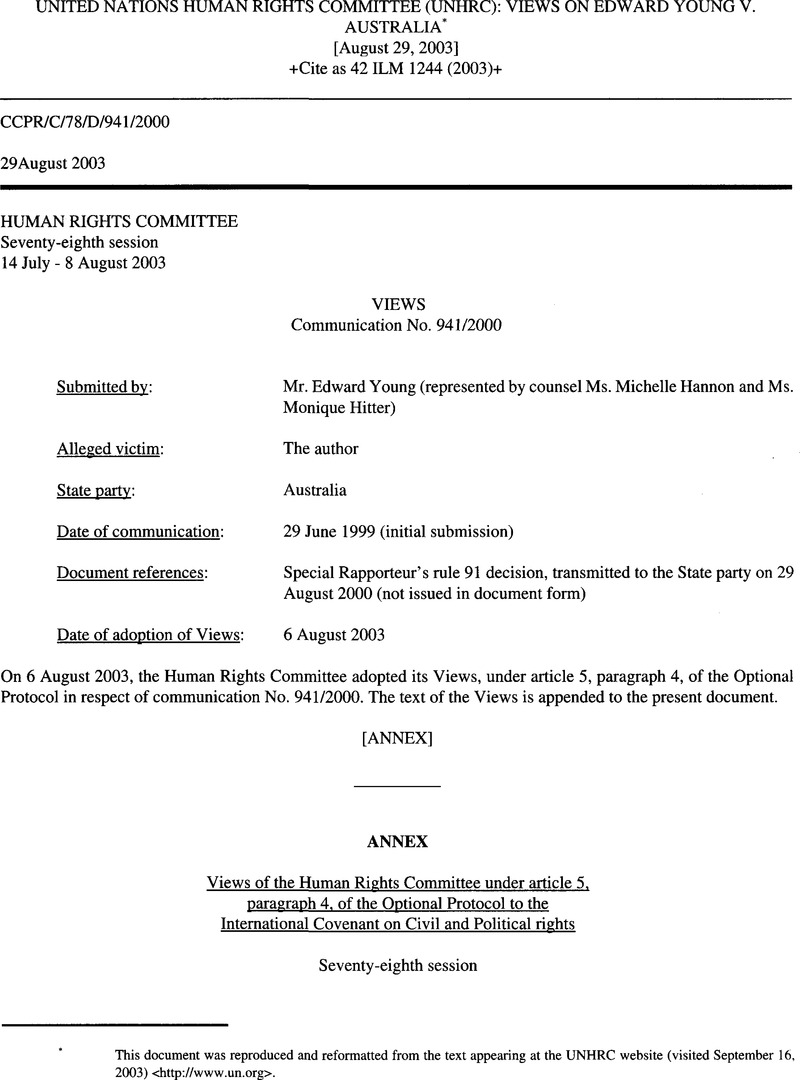Published online by Cambridge University Press: 27 February 2017

This document was reproduced and reformatted from the text appearing at the UNHRC website (visited September 16, 2003) <http://www.un.org>.
** The following members of the Committee participated in the examination of the present communication: Mr. Prafullachandra Natwarlal Bhagwati, Mr. Alfredo Castillero Hoyos, Mr. Franco Depasquale, Mr. Maurice Glélé Ahanhanzo, Mr. Walter Kälin, Mr. Rajsoomer Lallah, Mr. Rafael Rivas Posada, Sir Nigel Rodley, Mr. Martin Scheinin, Mr. Hipólito Solari Yrigoyen, Ms. Ruth Wedgwood and Mr. Roman Wieruszewski.
1 The author does not make any specific claim on this fact.
2 Case No. 172/1984, Views adopted on 9 April 1987.
3 Case No. 182/1984, Views adopted on 9 April 1987.
4 Case No. 180/1984, Views adopted on 9 April 1987.
5 Case No. 488/1992, Views adopted on 31 March 1994.
6 The State party refers to the travaux préparatoires of the Covenant and its Views in the communications of Broeks v. the Netherlands, Danning v. the Netherlands, Zwaan de Vries v. the Netherlands, supra.
7 The State party refers to UN Doc. A/42/40, page 139, paragraphs 12.1 to 1.13 and the communications Broeks v. the Netherlands, Danning v. the Netherlands and Zwaan de Vries v. the Netherlands, supra.
8 The State party refers to the following communications in an attempt to show that the author has not sufficiently demonstrated that he is a victim: J.H v. Canada, Case No. 187/1985, Decision adopted on 12 April 1985; Tadman et al v. Canada, Case No. 816/1998, Decision adopted on 29 October 1999; de Groot v. Netherlands, Case No. 578/1994, Decision adopted on 14 July 1995; Toonen v. Australia, supra.
9 The State party refers to the following reports of the Human Rights Committee in UN Documents A/48/40, paragraph 781; KIAIIAQ, paragraph 625; A/46/40, paragraph 679; A/45/40, paragraph 608; A/44/40, paragraph 633; A/43/40, paragraph 654; A/39/40, paragraph 588; A/52/40, paragraph 478; A/51/40, paragraph 388; A/50/40, paragraph 500; Old Bahamonde v. Equatorial Guinea, Case No. 468/1991, Views adopted on 20 October 1993; J. A. M. B.-R. v. the Netherlands, Case No. 477/1991,Decision adopted on 7 April 1994.
10 The State party refers to the following communications: Kelly v. Jamaica, Case No. 537/1993, Views adopted on 17 July 1996; Henry et al. v. Jamaica, Case No. 571/1994, Views adopted on 25 July 1996; Pereira, on behalf of Colamarco Patino v. Panama, Case No. 437/1990, Decision adopted on 21 October 1994; G v. Canada, Case No. 934/2000, Decision adopted on 17 July 2000; A v. New Zealand, Case No. 754/1997, Views adopted on 15 July 1999; Mansur et al. v. the Netherlands, Case No. 883/1999,Decision of 5 November 1999; Maille v. France, Case No. 689/2000, Views adopted on 10 July 2000; and Gomez Vazquez v. Spain, Case No. 701/1996, Views adopted on 20 July 2000.
11 The State party refers to Neefs v. the Netherlands, Case No. 425/1990, Views adopted on 15 July 1994, as an example.
12 The State party provides and refers to the following documents submitted by Mr. C to support this view (a) Claim for Service Pension by a Veteran or Mariner, pages 2, 3, 5 and 6; (b) Lifestyle Report, particularly Section 2 ‘Personal Relationships', in which there is no reference to a partner, and Section 4 ‘Recreation and Community Activities', in which Mr. C says that he rarely receives visitors either by friends or family; (c) Medical Examination — Psychiatric, in which there is no reference to a partner.
13 Communication No. 602/1994, Views adopted on 3 November 1998. In this case, the Committee held, on the merits, that “on the basis of the information before it, it appears that the author, even if he had been married to his partner rather than cohabitating with her without marriage, would not have been entitled to a pension under the AWW, since he was under 40 years of age, not unfit for work and had no unmarried children to care for. The matter before the Committee is thus confined to the entitlement to a temporary benefit only.“
14 The author refers to: Barzhig v. France, supra; Collins v. Jamaica, Case No. 356/1989, Views adopted on 12 May 1993; Maille v. France, supra; and Gómez Vazquez v. Spain, supra.
15 The author provides a statement regarding his relationship with Mr. C and eight statements from others attesting to the existence of a genuine and longstanding relationship between them. In the author's further submission, of 2 April 2002, he submits that he does not request the Committee to make determinations of fact on this evidence but provides it only to refute the material provided by the State party.
16 The author provides the decision which states that: “The Board … was sympathetic to his position of having had a long-term relationship with the late veteran.” It then sets out the relevant provisions of the VEA relating to the definition of a dependant and states “under the current legislation the Board is required to affirm the decision under review in relation to the status of the applicant.“
17 The author provides his own summary of some Defence Department policies on recognition of same sex relationships.
18 The State party provides copies of sections 25 and 43 of the Administrative Appeals Tribunal Act 1975, which describes the functions of the AAT.
19 Barzhig v. France, supra.
20 Toonen v. Australia, supra.
21 Dunning v. the Netherlands, supra.
22 Toonen v. Australia, Communication No. 488/1992, Views adopted on 4 April 1994.
23 Id., paragraph 6.2
24 Id., paragraph 3.l(a).
25 Mr. Young stated that he was the companion of Mr. C for 38 years, beginning in 1960. Mr. C served in the Australian armed forces for a period of three years, during World War Two. The commission hearing officer expressed “regret that I am … unable to exercise any discretion in this matter.” Id., paragraph 2.2